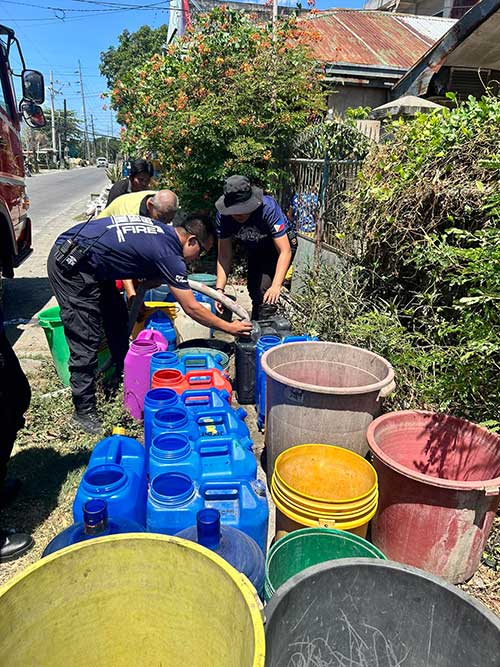
By Joseph Bernard A. Marzan and Mariela Angella Oladive
Despite receiving donations and declaring a state of calamity, which allows tapping into emergency funds, Iloilo City continues to face a critical water shortage due to the severe effects of the El Niño phenomenon.
The city government awarded the Notice to Proceed for the procurement of 696.9 million liters of water, funded through the Quick Response Fund (QRF), on May 10.
City Administrator Melchor Tan, during a press conference with Mayor Jerry Treñas on Monday, May 13, said that water distribution is set to commence pending preparations by the City Disaster and Risk Reduction Management Office (CDRRMO).
Donna Magno, head of the CDRRMO, confirmed that plans are in place to distribute 500,000 liters daily across the city’s 180 barangays.
Additionally, FLO Water Resources Inc. and Bombo Radyo Foundation Inc. have contributed 10 million liters of water.
As of 8:00 p.m. on Sunday, May 12, the CDRRMO’s Emergency Operations Center reported that 422,400 liters had been distributed to 48 barangays using tankers from the Bureau of Fire Protection (BFP), Metro Pacific Iloilo Water (MPIW), Iloilo Citizens’ Action Group (ICAG), and Federation Iloilo Fire Brigade, Inc. (FedFire).
Mayor Treñas announced upcoming discussions with MPIW and South Balibago Waterworks (SBW) to strategize on securing additional water supplies.
Neil Ravena, head of the General Services Office (GSO), revealed that a simulation exercise began on Monday afternoon, utilizing an algorithm to optimize the timeliness and efficiency of water delivery.
Treñas reassured residents that Magno and Ravena were managing the situation effectively and hinted that water supply augmentation might continue into the next year if necessary.
He also highlighted concerns about the safety and cost of water being sold in drums, describing it as “expensive and unsafe.”
“I do not know if that is enough, what we had procured, but [Magno] will have more funds available if needed, and one thing that we are looking at, just in case we meet with [SBW] and [MPIW], if needed, we can go on until next year if we have the funds,” the mayor said.
“It’s expensive to buy [water] from drums being peddled, and you wouldn’t know where that would come from. So, you do not really know if that’s treated or untreated, or treated [but] contaminated,” he added.
The mayor discussed a proposal from the Aboitiz Group for bulk water supply, which has been referred to MPIW and the Metro Iloilo Water District, and will be evaluated by the city’s Public-Private Partnership (PPP) Center.
DISTRIBUTION BEGINS WEDNESDAY
Iloilo City is poised to commence full-scale distribution of purchased potable water to affected communities this Wednesday, May 15, as part of its efforts to address the ongoing water shortage crisis.
Approximately 48 barangays in the city are grappling with water issues due to the effects of El Niño.
Ravena, head of the General Services Office (GSO), told Aksyon Radyo that a planned dry run and simulation exercise, originally set for Monday, May 13, was postponed.
Instead, representatives from Metro Pacific Iloilo Water (MPIW) and South Balibago Waterworks (SBW) met later that afternoon to plan which barangays would be prioritized for water distribution and to determine how the delivery would be managed between the two bulk water suppliers.
The city aims to distribute 500,000 liters of water to the impacted communities.
Funded by the city government’s quick response fund, the potable water is supplied by the aforementioned utilities.
The initial report also noted that the Commission on Audit (COA) will require barangays to provide documentation signed by the barangay council as part of the distribution oversight.
Moreover, a GSO inspector will be deployed to oversee the water distribution process to ensure its effectiveness and fairness.
In response to the drought, the city plans to replace flowers along Benigno Aquino Jr. Avenue with bougainvillea, which requires less water.
Ravena encouraged barangays to invest in static tanks to ensure a local water reserve for emergencies.
PERSONNEL
On personnel adjustments, Treñas noted that staff from the GSO and the Iloilo City Traffic Management Unit (ICTMU) have been reorganized to address potential heat-related issues.
ICTMU chief Uldarico Garbanzos explained that their heat-response strategy involves three “keywords”: ‘heatstroke break’, ‘visibility’, and ‘reactionary’.
Heatstroke break refers to providing traffic enforcers a break in extreme heat conditions, while visibility refers to their presence during rush hour especially at choke points.
Reactionary means that between 12:00 noon to 4:00 p.m., they would simply be reactive to traffic situations and be on the side of the roads when idle.
“We have inspectors [doing] inspections [of traffic enforcers’ compliance], monitoring via [closed-circuit television cameras] being operated through the [Operations Center], and of course, we remind our personnel to bring [their own] water to avoid complications from the heat,” Garbanzos said.
“We emphasize that they are ‘reactionary’ when there is congestion, that is the time when they react, [especially] during [the] 12:00 noon to 4:00 p.m. periods of the day,” he added.


















